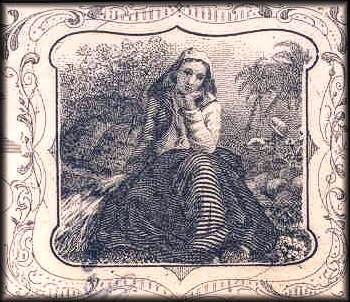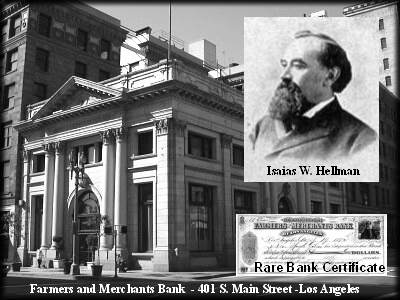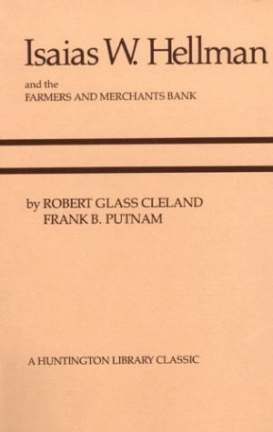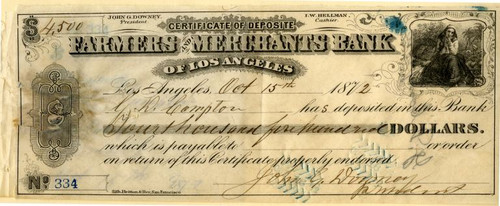Engraved certificate from the Farmers and Merchants Bank of Los Angeles issued in 1872. Early certifcates from Los angeles are very hard to find. This historic document was printed by Lith. Britton and Rey, San Francisco Company and has a border around it with a vignette of a woman sitting on hay with a basket of picked vegetables on her side. This cancelled item has the hand signature of the Company's Cashier, Isaias W. Hellman. There is some minor ledger stain on left side and overall is in fine condition. This item is over 147 years old. 
Certificate Vignette The Farmers and Merchants Bank was the first incorporated bank in Los Angeles, founded in 1871 by John D. Downey and Isaias W. Hellman, a successful merchant, real estate speculator and banker, and brother of Hermann W. Hellman. The Farmers and Merchants Bank was the oldest bank in Southern California from 1871 until 1956 when it was merged into the Security First National Bank of Los Angeles. The story of the Farmers and Merchants Bank coincides with the development of Los Angeles, particularly in the formative period from 1870 to 1900. 
Isaias W. Hellman Born Isaias Wolf Hellman October 3, 1842 Reckendorf, Bavaria Died April 9, 1920 (aged 77) San Francisco Isaias Wolf Hellman (October 3, 1842 April 9, 1920) was a German-born American banker and philanthropist, and a founding father of the University of Southern California. One of three sons and four daughters, Isaias was born in Reckendorf, Bavaria, to German Jewish parents Wolf Hellmann (18151884), a master weaver,[4] and Sara Fleischmann (18231888). He was educated in German public schools and at the College of Marktbreit, Bavaria. This school was founded by a Jew named Solomon Wohl in 1849. About half the students were gentiles. Isaias and his brother Herman W. Hellman left Hamburg on the steamer Hammonia, arriving in the Los Angeles, California on May 14, 1859 to join their cousins. A third brother James W. Hellman (1861-1940) also emigrated to Los Angeles. The four sisters were Bertha (b. 1845), Flora (b. 1846), Regina (b. 1848) and Ernestine (b. 1853). Ernestine married a wealthy cattle merchant named Schloss. Hellman went to work as a clerk in his cousins' dry goods store, and learned how to speak Spanish. He opened his own dry goods store in April 1865 on the Baker Block. Hellman became Los Angeles' first banker almost by accident. As a courtesy, he stored his customers' gold and valuables in a safe. One day, Hellman got into an altercation with a customer who had been coming in and out of the store gloriously drunk, withdrawing gold each time from a pouch stored in the safe. When the man sobered up, he was angry to discover he had spent most of his funds, and he lunged at Hellman. That interaction prompted Hellman to stop his informal banking operations. He got slips printed up that said I.W. Hellman, Banker, and started buying people's funds and issuing deposit books. On September 1, 1868, Hellman and Temple founded Hellman, Temple and Co., the fledgling city's second official bank. In 1871, Hellman and John G. Downey, a former governor of California, formed the Farmers and Merchants Bank of Los Angeles, which became Los Angeles' first successful bank. Hellman lent the money that allowed Harrison Gray Otis to buy the Los Angeles Times and Edward Doheny and Charles A. Canfield to drill for oil. Hellman was also a major investor in trolley lines, putting in funds in 1874 to start the Main Street and Agricultural Park Railway, which traveled from the Plaza, the heart of Los Angeles's downtown, to Agricultural Park, a popular horse-racing track. Hellman eventually invested in many of the city's rail lines and with Henry Huntington formed the Los Angeles Railway in 1898 and the Pacific Electric Railway in 1901. Hellman was also a major investor in Los Angeles's water, gas and electricity companies, and helped bring Southern Pacific Railroad to Los Angeles in 1876, which ended the isolation of the region. He was president of B'nai B'rith in 1872 when the congregation built the city's first temple on Fort Street. In 1870, his cousin Isaiah M. Hellman was elected City Treasurer. Hellman was also a major landowner in Southern California and his holdings included numerous city lots and vast swaths of former rancho land. In 1871, he and a syndicate bought the 13,000-acre (53 km2) Rancho Cucamonga. In 1881, Hellman and members of the Bixby family purchased the 26,000-acre (110 km2) Rancho Los Alamitos (now home to Long Beach and Seal Beach). He also purchased the Repetto Ranch (now Montebello) with Harris Newmark and Kaspare Cohn. Hellman and Downey also bought up swaths of Rancho San Pedro from the Dominguez family. Hellman also owned much of Boyle Heights with William H. Workman. In 1879, Judge Robert Maclay Widney established a board of trustees to create a new university. Hellman joined the businessman Ozro W. Childs and the former Governor of California John G. Downey in donating valuable land and an endowment to found the University of Southern California. In 1881, Hellman was appointed a Regents of the University of California to fill the unexpired term of D.O. Mills. He was reappointed twice and served until 1918. In 1890, Hellman moved to San Francisco to take over the Nevada Bank, which had been formed in 1875 by four men known as the Silver Kings: John MacKay, James Flood, William O'Brien and James Fair. While the bank had once had $10 million in capitalization, it was almost broke by the time Hellman took over. When word got out about Hellman's involvement, millionaires and capitalists from around the world applied to buy stock. Hellman had $15 million in applications but only $2.5 million in stock to sell. Two of the biggest shareholders included Mayer Lehman of Lehman Brothers ($150,000) and Levi Strauss ($120,000). Other shareholders included men Hellman had grown up with in Reckendorf who had become important businessmen in their own right, including Kalman, Abraham and William Haas, and David Walter. In 1893, Hellman incorporated the first trust company in California, the Union Trust Company. He was president of the Nevada Bank from 1890 to 1898 and the Nevada National Bank from 1898 to 1905. In 1897, Hellman bought a large parcel of land next to Lake Tahoe where he built a mansion in 1903. He named it Pine Lodge after the sugar pines that dotted the property. His family later sold this land to the state of California, which made the property into Sugar Pine Point State Park. He also purchased the 35,000-acre (140 km2) Nacimiento Ranch near Paso Robles and stocked it with cattle and horses. In 1905, Hellman merged the Nevada National Bank with Wells Fargo Bank to form the Wells Fargo Nevada National Bank. After the 1906 San Francisco earthquake, the bank was operated in the residence of Hellman's son-in-law at 2020 Jackson Street while the headquarters was rebuilt. At the height of his power, Hellman served as president or director of 17 banks along the Pacific Coast and controlled $100 million in capital. Family life He married Esther Newgass of New York on April 14, 1870. Her sister, Babette, was married to Mayer Lehman, one of the founders of Lehman Brothers. The couple had three children: Isaias William Hellman (1871-1920), Clara (1878-1959), and Florence (1882-1964).[6][7] Clara married Emanuel S. Heller and Florence married Sidney M. Ehrman who went on to form the law firm of Heller Powers & Ehrman. Legacy At his death in 1920, Hellman was considered the leading financier of the Pacific Coast. His son and grandson, Isaias Warren Hellman, later became presidents of Wells Fargo Bank. The Union Trust Company was merged with Wells Fargo after his death and the original Farmers and Merchants Bank later merged with Security First National Bank. Biographies of Hellman include Towers of Gold: How One Jewish Immigrant Named Isaias Hellman Created California, by Frances Dinkelspiel, his great-great-granddaughter. The 2008 book was on the San Francisco Chronicle bestseller list for five weeks and was reviewed favorably in the publication. -------------------- Isaias William Hellman,b. Oct.3, 1842, Reckendorf, Bavaria; d. April 9, 1920 ; came to the US in 1859; m. Esther Newgass, of New York on April 14, 1870. He arrived in L.A. in 1859 and began work as dry goods clerk; manager and president, Hellman, Temple and Co., bankers, 1868-71; He began in banking at Los Angeles in 1868 and founded the Farmers and Merchants Bank in 1871 and was its president from 1876-1920,: In 1890, he moved to San Francisco and he incorporated the Union Trust Company, the first trust company in California. Isaias William Hellman was president. He was also president, Bankers's Investment Co. Director: U.S. National Bank (Portland, Ore.), So. Pacific Co., many other corporations. He was also appointed to Regents of the University of California to fill unexpired term of Regent D. O. Mills, 1881-86; reappointed, 1886-1902; reappointed, 1902-18. 
Isaias W. Hellman and the Farmers and Merchants Bank Book published by the Huntington Library - Available on Amazon.com His home was located at 2020 Jackson St. office 2 Montgomery St., San Francisco, California. The bank operated from his home on Jackson Street after the main branch was destroyed in the 18-Apr-1906 Fire and Earthquake. His son and grandson were later presidents of Wells Fargo Bank. Isaias William Hellman was also a co founder of the University of Southern California (USC). In 1879, three civic leaders, Ozro W. Childs, a Protestant horticulturalist; John G. Downey, an Irish-Catholic pharmacist who had served as governor of California from 1860 to 1862; and Isaias W. Hellman, a German-Jewish banker and philanthropist, deeded 308 lots to the Board of Trustees, located in an area designated "West Los Angeles," near the intersection of Figueroa Street and Exposition Boulevard. Sales of the lots were to create an endowment to provide seeds of financial support for the institution. A portion of the land, located within the original land grant establishing El Pueblo de la Reina (Reyna) de Los Angeles, was to be reserved for the actual campus. The university opened in 1880 with 53 students and 10 teachers. History from Wikipedia and OldCompany.com (old stock certificate research service).

Certificate Vignette


Isaias W. Hellman and the Farmers and Merchants Bank Book published by the Huntington Library - Available on Amazon.com







